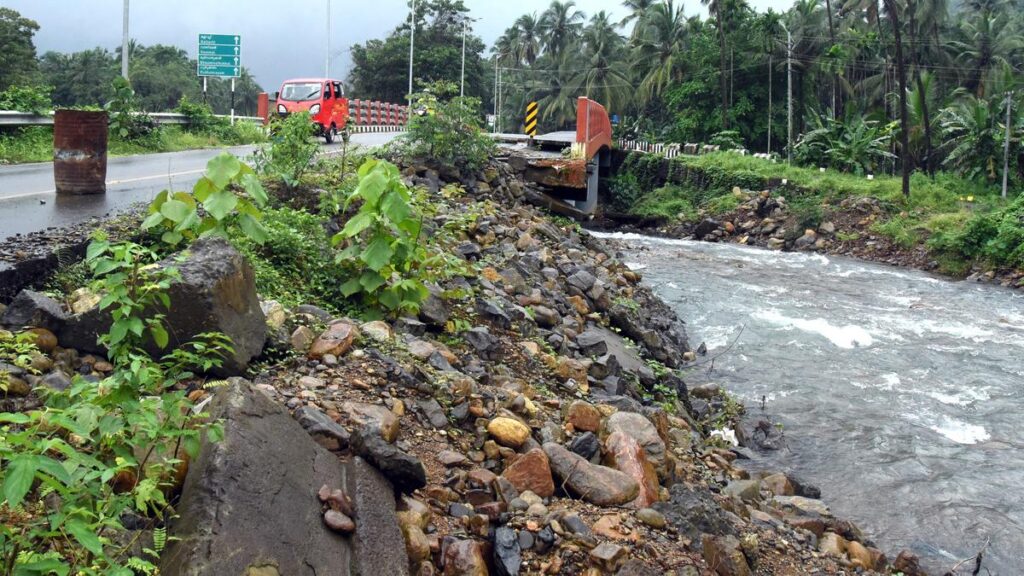
The approach road to the Urutti bridge at Vilangad was damaged in the landslide a year ago and has not been repaired yet.
| Photo Credit: K. Ragesh
A year after the devastating landslip struck Vilangad in rural Kozhikode, the deep scars left by nature’s fury and alleged institutional negligence continue to torment its residents.
“That was my shop where the boulder stands now,” says Thomas, known to everyone as Baby. “It was a four-room shop. It was my livelihood. I have not received any help from anyone.”
Vilangad, a peaceful village over 70 km from Kozhikode city, was reduced to a site of destruction, fear, and helplessness in a single night on July 30, 2024.
The Valook bridge in Vilangad town and the skeleton of the bus waiting shed that was damaged in the landslide a year ago.
| Photo Credit:
K. Ragesh
The massive landslide tore through the village, devouring everything on its path, from homes, shops, and schools to churches. K.A. Mathew, a retired teacher, lost his life during the rescue operation.
In the wake of the disaster, the State government pledged a ₹2-crore river renovation project. For the villagers, it was a glimmer of hope that the same river that wreaked havoc could be controlled and made safe. But it is yet to be fulfilled.
A view from Manjacheeli in Vilangad that experienced the maximum loss in the July 2024 landslide.
| Photo Credit:
K. Ragesh
“The only visible work has been the collection of debris and its careless dumping along the banks of the same river. Every time it rains, that same debris washes back into the water, nullifying the little effort that was made,” says Vinoy Thomas, a resident and head of Kerala Vyapari Vyavasayi Ekopana Samithi (KVVES) Vilangad unit.
Thirty-one families lost their homes, and the compensation took 10 months to materialise. The families were each given the promised amount of ₹15 lakh. Business owners of Vilangad received aid, not from the government but from KVVES, which distributed ₹30 lakhs amongst them.
Several bridges collapsed during the landslip, including the main ones connecting Vilangad to Naripetta grama panchayat, Vilangad bridge, Vayad bridge, Urruttipalam, and Manjachili bridge. Makeshift bridges have been erected, but they were never meant for heavy traffic.
During heavy rain, St. George’s High School becomes a relief camp. It opens its doors to families fleeing the rising river, turning classrooms into shelters. “This year, 80 students dropped out of the school. The school has become a ‘camp-school’,” says Shebi Sebastian, a member of the parent-teacher association.
The Kerala Catholic Bishops’ Council has promised 50 new houses. One has been completed, while the construction of others is on. For many, the tragedy of 2024 was not the first. Parts of Vilangad were declared unsafe as early as 2019, after another landslide. Back then, too, homes were promised.
Today, those houses are still unfinished, and residents live in them without a proper water supply or sanitation. “Our women walk to collect water, or we store rainwater and use that,” says Nanu, a resident of Addupil Unnathi of Vilangad.
Published – July 30, 2025 09:59 pm IST


